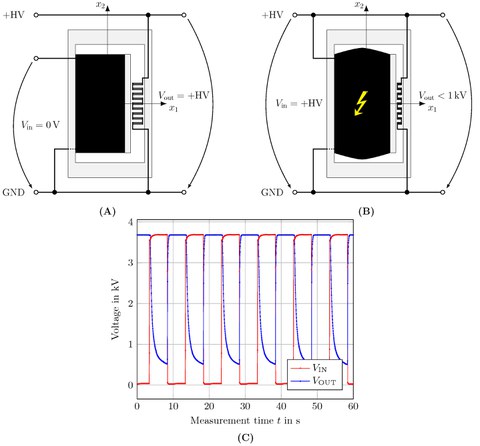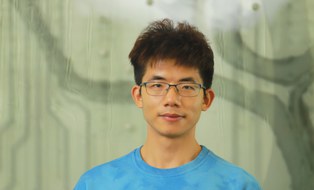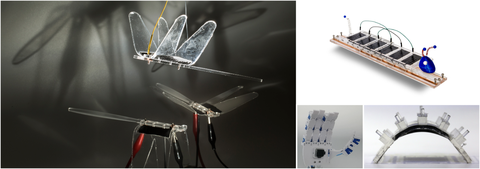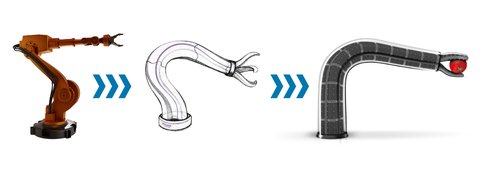Emmy Noether Junior Research Group MEiTNER
The Vision of a Soft Robotic Future
Conventional robots usually consist of heavy and rigid components, such as motors, gearboxes, and linkages, that are made of high-density materials. Although they can perform complex movements and processes, they are typically not able to perform movements similar to those of biological models. Entirely soft robots with animal-like behaviour will open up totally new perspectives and applications. The MEiTNER project will investigate multifunctional dielectric elastomers (DEs), so-called artificial muscles. The aim is to equip these dielectric elastomers with inherent signal-processing capabilities in the form of dielectric elastomer electronics, only made of polymer materials and carbon. This will enable a totally new class of soft electronics, controlling autonomous, entirely soft robots, without the need of conventional, stiff silicon-based controllers.
Novel soft DE-electronics will be integrated onto dielectric elastomer membranes using compliant electrodes with different electrical properties, such as resistance, capacitance and percolation. All these components will consist only of mixtures of polymers and conductive fillers. To validate functionality of developed processes and subcomponents, there will be investigations in advancing soft biomimetic robotics in general to demonstrate the potential of multifunctional DEs. Those robotic structures will be based on compliant mechanical structures, having distributed dielectric sensor-, actuator- and signal-processing nodes embedded throughout their entire structure.
We will investigate biomimetic approaches for several tasks such as locomotion, wing-flapping or under-water propulsion and related interfaces to the environment such as direction friction or electrostiction structures. In a second research direction we will investigate human-machine interfacing in collaborative robotics, industrial and medical applications. The technologies and DE electronics and software design tools, developed in FAB-1, shall be used to investigate prospects for soft, multi-functional structures that shall serve as compliant interfaces for machine operators, medical products and industrial applications such as soft robotic grippers.
Research Fields
Multifunctional Dielectric Elastomers
Within the range of soft functional materials, there is one with mechanical characteristics
similar to biological muscles: dielectric elastomer actuators (DEAs), a sub-type of soft polymeric actuators, so-called electroactive polymers (EAPs), well known for their robotic applications. Its mechanism is electro-mechanical, offering the opportunity for rapid and fully integrated control of actuation. In its simplest embodiment, a DEA is a flexible capacitor consisting of a thin, soft, pre-stretched dielectric membrane such as acrylic tape or silicone rubber.
Different kinds of DE actuators
A membrane of typically 50 μm thickness is flanked on both sides by a stretchable electrode. Application of charge to the electrodes produces an electrostatic Maxwell pressure MAXW, resulting in in-plane expansion and across-thickness contraction. With impressive operating capabilities that include maximum areal strains in excess of 1692%, DEA can be made to match and exceed the performance of natural muscles, earning the moniker of artificial muscles.
In addition to being used as actuators with large actuation, dielectric elastomer (DE)

Schematic of a digital inverter made of DEs: (A) low input voltage, high output voltage, (B) high input voltage, low output voltage, (C) experimental measurement of inverter switching between both states.
devices can perform as sensors for large strain and as energy harvesters to transform mechanical work into electrical energy. Some of these functions can be combined in a single assembly. One way to achieve localized, self-regulated DEA charge control is to use strain directly as a means for electronic charge switching. Our partners at the Biomimetics Lab at the University of Auckland have identified a suitable highvoltage switching material, consisting of carbon particles in silicone grease, that can be imprinted on the membrane surface or alongside a DEA: the dielectric elastomer switch (DES). The conductivity of a DES changes by several orders of magnitude through a voltage-
DE-electronics working as multiplexer to choose between different signals
induced elongation of an adjacent DEA. DEAs and DESs can be combined together as strain-dependent electrical signal inverters. Those digital units can furthermore, theoretically, be assembled to every desirable logic circuit, using either a combination of the six basic BOOLean gates, or a number of NAND gates, respectively. In our group we develop electic circuitry to contorl and drive soft robotics with DE-electronics. The video on the left shows a DE multiplexer made of DEAs and DESs. We also develop oscillators that provide a basis for periodic charge control; emulating the role of a biological central pattern generator (CPG) neural network. Summarizing this, the multifunctional dielectric elastomer technology represents one of the most promising technologies to develop a toolkit for entirely soft robotic structures that only need a DC voltage to run their soft signal-processing units that power their soft actuators embedded in an entirely soft structure.
Soft Robotics
Dielectric Elastomers ar well suited to be integrated into soft robotic structures. Soft DE artificial muscles and actuator soft robotic structures, soft tactile skins can give reflexes to them and digital DE-electronics and be used to perform signal processing directly in soft robotic structures. The MEiTNER reserach group is developing soft robotic structures, that embedd novel DE-electronics in order to give them reflexes, automonous signal processing capabilities and bio-inspred actuation. We combine pneumatics, DE-electonics and artificial muscles in our demonstarators.
Tactile surfaces and soft sensors
For a close collacboation between humans and robots, we develop soft senors that can tectect touch and pressure. These sensors based on DEs and are entirely made of silicone and carbon. Our vision is a future where we humans can interact with robotic as we du with other humans. For that print piezoresistive and capacitive sensors and sensor arrays that are fully flexible and strechable and can be applied directly in or on soft robotic structures.
Biomimetics
We research how DE-electronics can drive soft robotic structures of the future. For that we investigate biological rolemodels and implement bio-inspred designs and control pardigms in our bio-inspred robotic structres. For that we collaborate with researchers at the Biomimetics Lab at the University of Auckland in New zealand and a university spinout comapny PowerON.
Group members
Group leader
 © Georgi Paschew
© Georgi Paschew
Research Group Leader
NameMr Dr.-Ing. E.-F. Markus Vorrath (geb. Henke)
Emmy Noether Research Group MEITNER
Send encrypted email via the SecureMail portal (for TUD external users only).
Visiting address:
N67, Room B.210 Nöthnitzer Straße 67
01187 Dresden
PhD Students
 © NO
© NO
Research associate
NameMr M.Sc. Luca Ciarella
Send encrypted email via the SecureMail portal (for TUD external users only).
Visiting address:
N67, Room 212 Nöthnitzer Straße 67
01187 Dresden
 © No
© No
Scientific Associate
NameMr M.Sc. Jianan Yi
Send encrypted email via the SecureMail portal (for TUD external users only).
Visiting address:
N67, Room B.118 Nöthnitzer Straße 67
01187 Dresden
 © TU Dresden
© TU Dresden
Scientific associate
NameMr M.Sc. Artem Prokopchuk
Send encrypted email via the SecureMail portal (for TUD external users only).
Visiting address:
N67, Room B.118 Nöthnitzer Straße 67
01187 Dresden
Students
- Alexander Gubsch
Alumni
- Dipl.-Ing. Rafał Andrejczuk
- Dipl.-Ing. Junaho Ni


